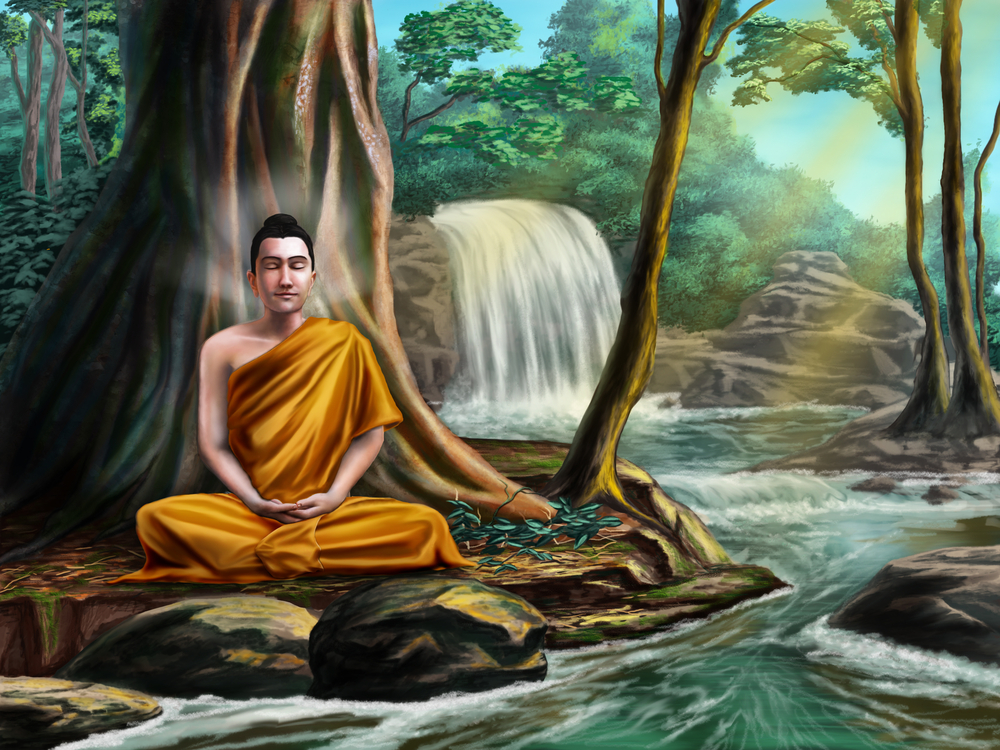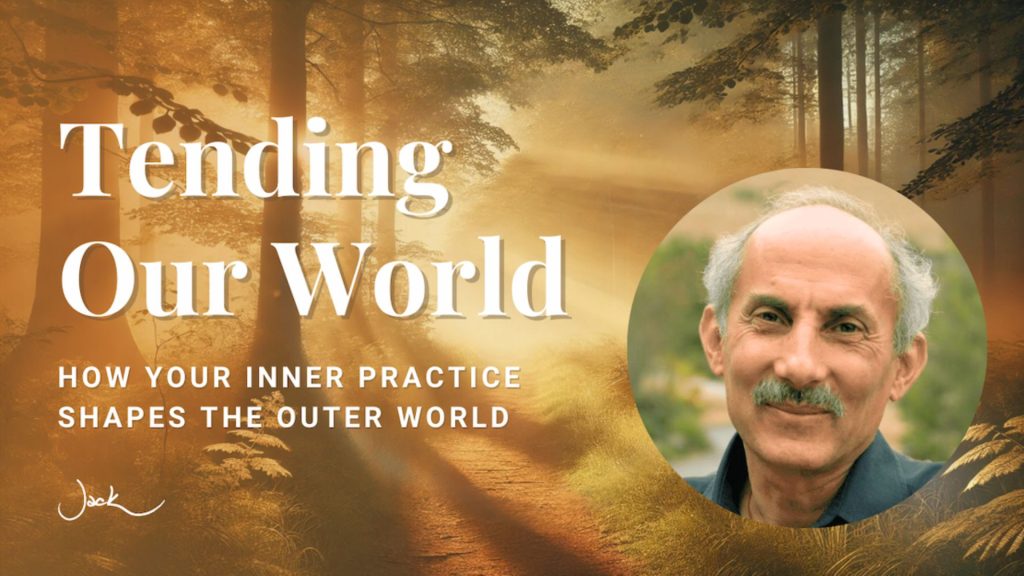Meditation comes alive through a growing capacity to release our habitual entanglement in the stories and plans, conflicts and worries that make up the small sense of self, and to rest in awareness. In meditation we do this simply by acknowledging the moment-to-moment changing conditions—the pleasure and pain, the praise and blame, the litany of ideas and expectations that arise. Without identifying with them, we can rest in the awareness itself, beyond conditions, and experience what my teacher Ajahn Chah called jai pongsai, our natural lightness of heart. Developing this capacity to rest in awareness nourishes samadhi (concentration), which stabilizes and clarifies the mind, and prajna (wisdom), that sees things as they are.
We can employ this awareness or wise attention from the very start. When we first sit down to meditate, the best strategy is to simply notice whatever state of our body and mind is present. To establish the foundation of mindfulness, the Buddha instructs his followers “to observe whether the body and mind are distracted or steady, angry or peaceful, excited or worried, contracted or released, bound or free.” Observing what is so, we can take a few deep breaths and relax, making space for whatever situation we find.
From this ground of acceptance we can learn to use the transformative power of attention in a flexible and malleable way. Wise attention—mindfulness—can function like a zoom lens. Often it is most helpful to steady our practice with close-up attention. In this, we bring a careful attention and a very close focus to our breath or a sensation, or to the precise movement of feeling or thought. Over time we can eventually become so absorbed that subject and object disappear. We become the breath, we become the tingling in our foot, we become the sadness or joy. In this we sense ourself being born and dying with each breath, each experience. Entanglement in our ordinary sense of self dissolves; our troubles and fears drop away. Our entire experience of the world shows itself to be impermanent, ungraspable and selfless. Wisdom is born.
But sometimes in meditation such close focus of attention can create an unnecessary sense of tightness and struggle. So we must find a more open way to pay attention. Or perhaps when we are mindfully walking down the street we realize it is not helpful to focus only on our breath or our feet. We will miss the traffic signals, the morning light and the faces of the passersby. So we open the lens of awareness to a middle range. When we do this as we sit, instead of focusing on the breath alone, we can feel the energy of our whole body. As we walk we can feel the rhythm of our whole movement and the circumstances through which we move. From this perspective it is almost as if awareness “sits on our shoulder” and respectfully acknowledges a breath, a pain in our legs, a thought about dinner, a feeling of sadness, a shop window we pass. Here wise attention has a gracious witnessing quality, acknowledging each event—whether boredom or jealousy, plans or excitement, gain or loss, pleasure or pain—with a slight bow. Moment by moment we release the illusion of getting “somewhere” and rest in the timeless present, witnessing with easy awareness all that passes by. As we let go, our innate freedom and wisdom manifest. Nothing to have, nothing to be. Ajahn Chah called this “resting in the One Who Knows.”
Yet at times this middle level of attention does not serve our practice best. We may find ourself caught in the grip of some repetitive thought pattern or painful situation, or lost in great physical or emotional suffering. Perhaps there is chaos and noise around us. We sit and our heart is tight, our body and mind are neither relaxed nor gracious, and even the witnessing can seem tedious, forced, effortful.
In this circumstance we can open the lens of attention to its widest angle and let our awareness become like space or the sky. As the Buddha instructs in the Majjhima Nikaya, “Develop a mind that is vast like space, where experiences both pleasant and unpleasant can appear and disappear without conflict, struggle or harm. Rest in a mind like vast sky.”
From this broad perspective, when we sit or walk in meditation, we open our attention like space, letting experiences arise without any boundaries, without inside or outside. Instead of the ordinary orientation where our mind is felt to be inside our head, we can let go and experience the mind’s awareness as open, boundless and vast. We allow awareness to experience consciousness that is not entangled in the particular conditions of sight, sound and feelings, but consciousness that is independent of changing conditions—the unconditioned. Ajahn Jumnien, a Thai forest elder, speaks of this form of practice as Maha Vipassana, resting in pure awareness itself, timeless and unborn. For the meditator, this is not an ideal or a distant experience. It is always immediate, ever present, liberating; it becomes the resting place of the wise heart.
Fully absorbed, graciously witnessing, or open and spacious—which of these lenses is the best way to practice awareness? Is there an optimal way to pay attention? The answer is “all of the above.” Awareness is infinitely malleable, and it is important not to fixate on any one form as best. Mistakenly, some traditions teach that losing the self and dissolving into a breath or absorbing into an experience is the optimal form of attention. Other traditions erroneously believe that resting in the widest angle, the open consciousness of space, is the highest teaching. Still others say that the middle ground—an ordinary, free and relaxed awareness of whatever arises here and now, “nothing special”—is the highest attainment. Yet in its true nature awareness cannot be limited. Consciousness itself is both large and small, particular and universal. At different times our practice will require that we embrace all these perspectives.
Every form of genuine awareness is liberating. Each moment we release entanglement and identification is selfless and free. But remember too that every practice of awareness can create a shadow when we mistakenly cling to it. A misuse of space can easily lead us to become spaced-out and unfocused. A misuse of absorption can lead to denial, the ignoring of other experiences, and a misuse of ordinary awareness can create a false sense of “self” as a witness. These shadows are subtle veils of meditative clinging. See them for what they are and let them go. And learn to work with all the lenses of awareness to serve your wise attention.
The more you experience the power of wise attention, the more your trust in the ground of awareness itself will grow. You will learn to relax and let go. In any moment of being caught, awareness will step in, a presence without judging or resisting. Close-in or vast, near or far, awareness illuminates the ungraspable nature of the universe. It returns the heart and mind to its birthright, naturally luminous and free.
To amplify and deepen an understanding of how to practice with awareness as space, the following instructions can be helpful. One of the most accessible ways to open to spacious awareness is through the ear door, listening to the sounds of the universe around us. Because the river of sound comes and goes so naturally, and is so obviously out of our control, listening brings the mind to a naturally balanced state of openness and attention. I learned this particular practice of sound as a gateway to space from my colleague Joseph Goldstein more than 25 years ago and have used it ever since. Awareness of sound in space can be an excellent way to begin practice because it initiates the sitting period with the flavor of wakeful ease and spacious letting go. Or it can be used after a period of focused attention.
Whenever you begin, sit comfortably and at ease. Let your body be at rest and your breathing be natural. Close your eyes. Take several full breaths and let each release gently. Allow yourself to be still.
Now shift awareness away from the breath. Begin to listen to the play of sounds around you. Notice those that are loud and soft, far and near. Just listen. Notice how all sounds arise and vanish, leaving no trace. Listen for a time in a relaxed, open way.
As you listen, let yourself sense or imagine that your mind is not limited to your head. Sense that your mind is expanding to be like the sky-open, clear, vast like space. There is no inside or outside. Let the awareness of your mind extend in every direction like the sky.
Now the sounds you hear will arise and pass away in the open space of your own mind. Relax in this openness and just listen. Let the sounds that come and go, whether far or near, be like clouds in the vast sky of your own awareness. The play of sounds moves through the sky, appearing and disappearing without resistance.
As you rest in this open awareness, notice how thoughts and images also arise and vanish like sounds. Let the thoughts and images come and go without struggle or resistance. Pleasant and unpleasant thoughts, pictures, words and feelings move unrestricted in the space of mind. Problems, possibilities, joys and sorrows come and go like clouds in the clear sky of mind.
After a time, let this spacious awareness notice the body. Become aware of how the sensations of breath and body float and change in the same open sky of awareness. The breath breathes itself, it moves like a breeze. The body is not solid. It is felt as areas of hardness and softness, pressure and tingling, warm and cool sensation, all floating in the space of the mind’s awareness.
Let the breath move like a breeze. Rest in this openness. Let sensations float and change. Allow all thoughts and images, feelings and sounds to come and go like clouds in the clear open space of awareness.
Finally, pay attention to the awareness itself. Notice how the open space of awareness is naturally clear, transparent, timeless and without conflict—allowing all things, but not limited by them.
The Buddha said, “O Nobly Born, remember the pure open sky of your own true nature. Return to it. Trust it. It is home.”
May the blessings of these practices awaken your own inner wisdom and inspire your compassion. And through the blessing of your heart may the world find peace.






